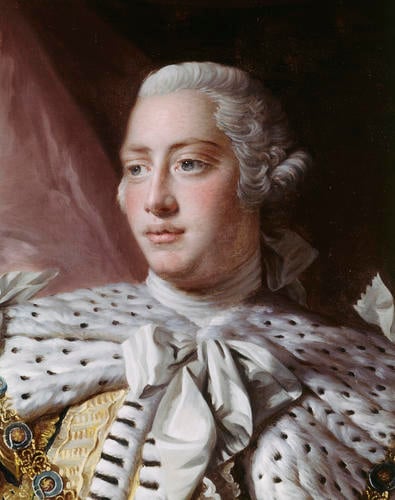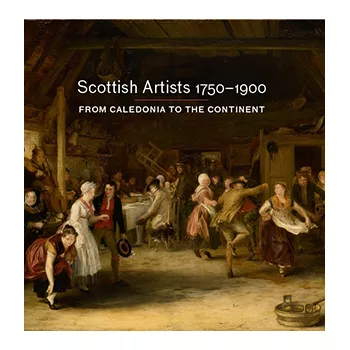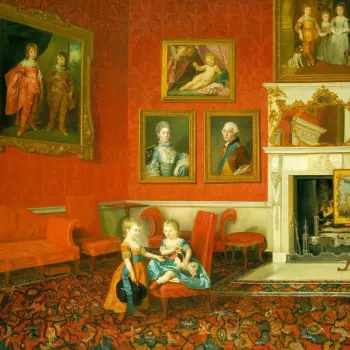George III (1738-1820) c.1761-2
Oil on canvas | 249.5 x 163.2 cm (support, canvas/panel/stretcher external) | RCIN 405307
-
This is the prime versions of Ramsay's State Portrait of George III in coronation robes. His coronation took place on 22 September 1761. The Scottish artist had already painted the sitter as Prince of Wales in 1758 for John Stuart, 3rd Earl of Bute, Ramsay's most important patron in London and George III's tutor and mentor. The success of that portrait and of a portrait of Bute (both Mount Stuart, Isle of Bute), led to this major commission. Ramsay wrote in 1766: 'I painted, from the life, a whole length picture of him for Hanover, a profile for the coinage, and another whole length which after the Coronation, I, by his Majesties orders dressed in Coronation robes. Soon after her Majesty's arrival, she likewise did me the honour to sit to me; and these two pictures in coronation robes are the originals from which all the copies ordered by the Lord Chamberlain are painted.' In December 1761 Ramsay reported to Lord Bute that he was also working on a version in coronation robes for Hanover and one for Lord Bute (Mount Stuart, Isle of Bute). Walpole recorded seeing the painting (presumably this one) in March 1762, 'painted exactly from the very robes which the king wore at his coronation'.
Through an error John Shackleton (who died in 1767) was reappointed to the post of Principal Painter in Ordinary to George III on the King's accession. Ramsay, however, was given the title 'one of His Majesty's Principal Painters in Ordinary' and assumed the duties of the King's painter. His studio in Soho Square was described as being 'crowded with portraits of His Majesty in every stage of their operation'. The demand for versions of these official State Portraits was immense, from members of the royal family, sovereigns, heads of state, colonial governors, ambassadors, corporations, institutions and courtiers. Orders for 150 pairs, 26 of the King alone, 9 of the Queen alone, are listed. Ramsay resolved to 'give the last painting to all of them with my own hand' but employed several assistants, the best of whom were David Martin and Philip Reinagle.
Four pairs of Ramsay's full lengths are documented in the royal palaces at an early date. This one did not appear in the set of c.1774 hanging plans of Buckingham House and may previously have hung at either St James's Palace or Carlton House. One of the pairs was painted for Augusta, Princess of Wales, and framed in 1767-8 by the King's cabinet-makers John Bradburn and William France. For the exhibition at The Queen's Gallery in 2004 this painting was removed from its permanent frame (dating from the 1830s) set into the wall of the State Dining Room at Buckingham Palace; it was temporarily placed in a frame supplied by Bradburn and France for another painting.
The elegant pose emphasises both the dignity and the reticence of the young King. Ramsay's debt to contemporary French art is evident, particularly to Jean-Marc Nattier and Louis-Michel van Loo. In Ramsay's painting of George III the face is confidently created using grey underpainting, the flesh is enlivened by small touches of vermilion and the thickness and texture of the robes are brilliantly suggested, including the reflected light on the ermine. This successful combination of graceful and majestic was followed by other commissions from the royal family. The strength of Ramsay's position in the King's household is illustrated by George III's refusal of Lord Eglinton's request that he sit to Ramsay's younger rival Reynolds, with the words: 'Mr Ramsay is my painter, my Lord.'
Catalogue entry adapted from George III & Queen Charlotte: Patronage, Collecting and Court Taste, London, 2004Provenance
Commissioned by George III; recorded in 1767 at Carlton House, the residence of George III's mother, Princess Augusta; probably in the King's Presence Chamber at Windsor Castle in 1813; certainly back at Carlton House in 1816 and 1819, when it is recorded in the Old Throne Room (no 15) and appears in Pyne's illustrated Royal Residences (RCIN 922179); in the Throne Room at Buckingham Palace in 1841 (no 186)
-
Creator(s)
-
Medium and techniques
Oil on canvas
Measurements
249.5 x 163.2 cm (support, canvas/panel/stretcher external)













